First Norman King of England
England's first Norman king, the formidable William I, was born in 1028 at Falaise Castle. Wiliam was the illegitimate son of Robert 'the Devil' or the Magnificent, Duke of Normandy and his mistress Herleve, (sometimes called Arlette) the daughter of Fullbert, a tanner of Falaise. Before history renamed him the Conqueror he was more commonly known to his contemporaries as William the Bastard. Herleve was reported to have attracted Duke Robert with her dancing, in some accounts, he is said to have first caught sight of her while she was washing her linen in the castle moat.
The Norman dynasty had been founded by Robert's ancestor Rollo or Hrolf the Ganger, a Viking raider chief, who was granted the duchy by Charles the Simple, King of France, in 911, at the Treaty of Saint-Clair-Sur-Epte, in exchange for feudal allegiance and conversion to Christianity at which he took the baptismal name of Robert.
Falaise Castle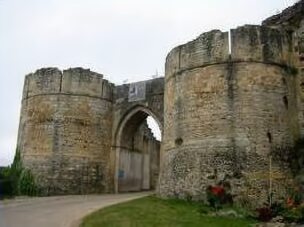
William's mother, Herleve, also had a daughter, Adelaide, to Duke Robert. Although they had a long relationship, the gap in their social standing rendered marriage out of the question and Herleve was married off to one of Robert's vassals, Herluin, a knight. From this marriage, Herleve produced two further sons, Robert, who later became Count of Mortain and Odo, destined to become Bishop of Bayeux and Earl of Kent and also to play a part in England's history.
William, Duke of Normandy
Duke Robert decided to expiate his sins, which were many, by going on pilgrimage in 1034. Since he had no legitimate heir to succeed him, he persuaded his unruly barons to accept the illegitimate William as the future Duke of Normandy. On his return journey from the Holy Land Robert died suddenly and the young William succeeded to the Dukedom by his father's will with his great-uncle Robert, archbishop of Rouen serving as Regent.
The barons exhibited no loyalty to the"'base born" child and thereafter William grew up in the school of adversity. He had to learn, very early, how to survive. The barons constantly rebelled and anarchy reigned in Normandy during the years of William's minority. William's guardians were murdered in succession. At first, custody of the young duke was given to Duke Alan of Brittany, after his death Gilbert of Brionne took charge of William. Gilbert was killed within months, and another guardian, Turchetil, was also killed around the time of Gilbert's death. Osbern, the nephew of Gunnor the wife of Duke Richard I, was killed whilst guarding his door. His maternal uncle, Walter, at one point, resorted to hiding the child with some poor people. In 1046, William's cousin, Guy of Burgundy, led a rebellion in Normandy and attempted to seize William at Valognes, forcing him to seek refuge with King Henry of France. William was formed and moulded by this savage and insecure childhood into the stark and often ruthless ruler he was later to become.
Statue of William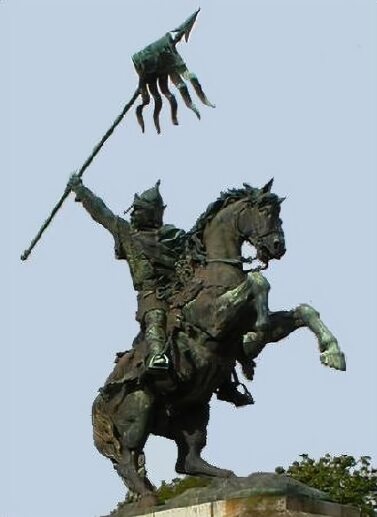
In 1047, he returned to Normandy and asserted his authority, crushing the rebels at Val-es-Dunes after which he began to restore order in his Dukedom. At Alencon, the burghers insulted his birth by hanging "hides for the tanner" over the walls. On taking the town he exacted a terrible revenge and had both their hands and feet amputated. One of life's great survivors, William finally emerged as undisputed Duke of Normandy.
William matured into a tall, thick-set man with reddish hair, which receded from his forehead early. According to measurements of his thigh bone, he stood about 5' 10" tall. His voice was rasping and guttural. William undoubtedly possessed considerable powers of leadership and courage. He was devout and inspired loyalty in his followers, but could also be ruthless and cruel.
William of Malmesbury provides us with a detailed description of the king in his Historia Anglorum:-
'He was of just stature, ordinary corpulence, fierce countenance; his forehead was bare of hair; of such great strength of arm that it was often a matter of surprise, that no one was able to draw his bow, which himself could bend when his horse was in full gallop; he was majestic whether sitting or standing, although the protuberance of his belly deformed his royal person; of excellent health so that he was never confined with any dangerous disorder, except at the last; so given to the pleasures of the chase, that as I have before said, ejecting the inhabitants, he let a space of many miles grow desolate that, when at liberty from other avocations, he might there pursue his pleasures.
His money anxiety is the only thing on which he can deservedly be blamed. This he sought all opportunities of scraping together, he cared not how; he would say and do some things and indeed almost anything, unbecoming to such great majesty, where the hope of money allured him. I have here no excuse whatever to offer, unless it be, as one has said, that of necessity he must fear many, whom many fear.'
William negotiated a marriage in 1049 to Matilda of Flanders, a descendant of the old Saxon House of Wessex and daughter of
Baldwin, Count of Flanders and Adela, daughter of Robert II, King of France. Tradition states that when Duke William sent representatives to her father's court to request Matilda's hand in marriage, she retorted by proudly informing the representative that she was far too high-born to consider marrying a bastard. Furious on receiving this response, William rode to Bruges, where he confronted Matilda on her way to church, he pulled her off her horse and threw her down in the street in front of her attendants and rode off. An alternative version of the legend states that he rode to her father's court in Lille, marched defiantly into her room and threw her to the ground in her room and hit her. Whereupon it is said Matilda refused to marry anyone but William. They were an ill-assorted pair, he strongly built and five feet ten inches tall and she ( as it emerged when her skeleton was exhumed) extremely short. It proved, however, to be a highly successful union and produced a large family.
The Conquest of England
The Duke of Normandy visited his English cousin, Edward the Confessor, in 1051. Edward and his brother Alfred had spent much of their childhood in exile at the Norman Court, their mother, Emma, had been a daughter of the House of Normandy. During this visit, Edward is purported to have promised his Norman cousin the crown of England, should he die without issue. The true heir was Edgar the Atheling, Edward's great-nephew, the grandson of his elder brother Edmund Ironside, but he was still a child and knew little of England, having spent much of his life in exile in Hungary. Others also coveted the English throne, the chief candidate amongst these was Harold, son of the powerful Godwine, Earl of Wessex, whose sister, Edith, was married to King Edward the Confessor.
Harold was unfortunately shipwrecked on the coast of Normandy, where he found himself the unwilling guest of Duke William. The Confessor was now unlikely to survive long and Harold was anxious to return to England to forward his ambitions there. However, before he would allow his guest to leave, William required him to swear an oath to support his claim to the crown upon Edward's death. Under duress, Harold finally consented and swore the oath on holy relics.
Edward the Confessor finally breathed his last in January 1066, and was buried in his foundation of St. Peter, Westminster, which had been consecrated but ten days previously. It was reported that on his deathbed he had nominated Harold Godwinson as his successor who was duly accepted as King by the Saxon Witangemot or council of elders, which traditionally elected the next English King.
Back in Normandy, on receipt of this ominous news, the formidable Duke William flew into a rage. He began to build an invasion fleet to take by force what he considered to be his by right. The Pope himself, due to Harold's foresworn oath on holy relics, supported William's enterprise. After Harold was crowned by Archbishop Stigand, a portentous star was seen in the skies, this has now been identified as Halley's comet, many in that superstitious age saw it as an omen of the wrath of God on the perjured King Harold and his followers.
Harold assembled the fyrd, the Saxon militia of freemen, in preparation for William's imminent landing, whilst the Duke prepared his fleet and waited for good weather to set sail for England. In mid-September, Harold Hardrada, King of Norway, invaded England, accompanied by Tostig, Earl of Northumbria, Harold's unruly and discontented brother, who had earlier been banished and his earldom confiscated.
William from the Bayeux Tapestry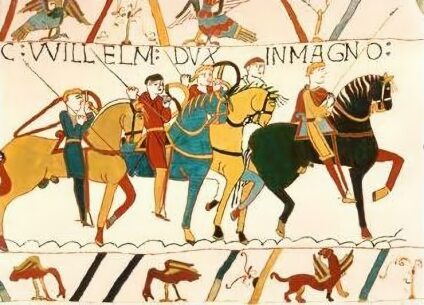
Harold marched his army north in haste to meet the invaders at Stamford Bridge in Yorkshire, where he
won a decisive victory over the Viking army. At this time, the winds William had been pensively awaiting turned favourable and he set sail with his massive invasion fleet. News of his landing at Bulverhythe was conveyed to Harold, who responded by hurrying south to meet him, giving his exhausted army no respite. Had Harold rested and reorganized his army, the outcome of the impending battle and English history could have been very different.
On 14th October, the Saxon and Norman forces clashed in the fateful Battle of Hastings. Harold took up a defensive position on Senlac Ridge. The Norman army was thus forced to attack uphill, placing them at a disadvantage.
The Saxon army formed a shield wall along the edge of the hill which rebuffed repeated Norman attacks. A rumour arose in the Norman ranks that Duke William was dead, causing panic and flight. Many of the Saxon fyrd pursued the fleeing Normans down the hill. William put heart into his army by loudly announcing he still lived. The Normans rallied, Harold's brothers Gyrth and Leofwine were both slain on the battlefield.
The battle continued for most of the day, Harold and his Saxons fought with steely determination for possession of their country. As dusk began to fall over Hastings, William ordered his archers to fire high into the air and one of these arrows is said to have hit Harold in the eye, blinding him, although this point is disputed by some sources. Whether this was the case or not, Harold fell mortally wounded under the dragon standard of Wessex.
The Saxon army, seeing that the day was lost, began to flee the field. The housecarls, Harold's trained professional militia, loyally and valiantly defended the body of their King to the last, but they too finally fell and Harold's body was mutilated by the Normans, a vindictive act, which William punished. The battle was lost and Anglo-Saxon England died with Harold on the battlefield that day.
Harold's Stone at Battle Abbey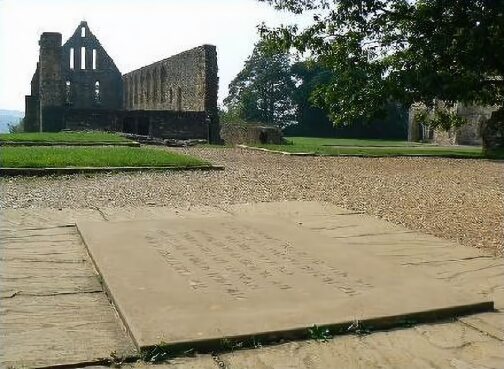
Harold's deeply distressed mistress, Edith Swan-neck came to William pleading for her lover's body and offering him its weight in gold in exchange, but William coldly refused her distraught request. He had Harold buried in a secret location. William proceeded to London, where he was crowned King of England at Edward the Confessor's foundation of Westminster Abbey on Christmas Day, 1066.
He accepted the surrender of the Saxon Earls Edwin of Mercia and Morcar of Northumbria along with that of the child claimant, Edgar Atheling. On the whole, the south of England submitted to Norman rule, whereas in the north resistance was more prolonged. William responded by subjecting the English to a reign of terror. Determined to punish and crush rebellion to his rule and strike abject fear into English hearts, he laid waste vast tracts of Yorkshire, which suffered under a great famine for nine years after as a result. He rewarded his Norman and French followers by distributing the confiscated lands of the English to them.
The Harrying of the North
In 1068 the brothers, Earls Edwin and Morcar rose in revolt with the support of Gospatric, William marched through Edwin's territory and built a castle at Warwick. Edwin and Morcar submitted, but William continued to York, building castles at York and Nottingham before returning south. On his journey south, William began constructing further castles at Lincoln, Huntingdon, and Cambridge and placed his supporters in charge of these new visible expressions of Norman power in England, among them William Peverel, thought to be his illegitimate son, at Nottingham and Henry de Beaumont at Warwick.
In 1069, Edgar Atheling rose in revolt against William's rule and attacked York. Although William returned to York and built another castle, Edgar remained at liberty, and in the autumn of that year he joined forces with King Sweyn of Denmark. The Danish king brought a large fleet to England and attacked not only York but Exeter and Shrewsbury. York was taken by the combined forces of Edgar and Sweyn. Edgar was duly proclaimed King of England by his Saxon supporters, but William responded with haste, ignoring a revolt in Maine. William symbolically wore his crown in the ruins of York on Christmas Day 1069, and then marched to the River Tees, ravaging the surrounding countryside as he proceeded north. Edgar fled to Scotland, where Malcolm III, King of Scots was married to his sister Margaret. Waltheof, Earl of Northumbria, who had joined the revolt, submitted to William, along with Gospatric, Earl of Northumbria, and both were pardoned and allowed to retain their lands. But William's vengeance was not satiated, he marched over the Pennines during the winter and defeated the remaining rebels at Shrewsbury before building two further castles at Chester and Stafford.
In 1070 the heroic Hereward the Wake rose in a rebellion against Norman rule which centred on the Isle of Ely. William led an army to Ely, where Hereward, joined by a small army led by Morcar, the former Saxon Earl of Northumbria made a desperate stand. Eventually, the Normans bribed Abbot Thurstan of Ely to reveal a safe route across the marshes, which resulted in Ely being taken. Morcar was captured and imprisoned, but Hereward managed to escape into the wild fenland to continue his resistance.
White Tower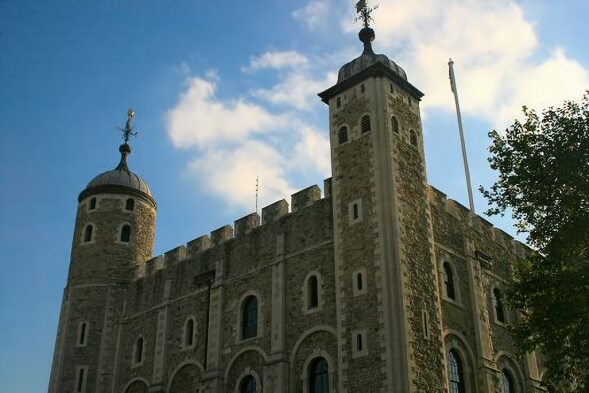
William was a savage and formidable ruler, by modern standards an exceedingly cruel one, but his methods produced the desired results and extinguished the fires of opposition. Many castles and keeps were built across the country to enforce his rule, originally wooden towers or earthen mottes, in all over 80 castles were established during the reign, including the White Tower, the first building in the Tower of London complex. The dominating shadow of the White Tower loomed menacingly over medieval London, a visible expression of Norman power.
Anglo-Saxon England was radically altered by the Norman conquest, it changed the entire way of life then established in the country. Its laws, aristocracy and church were altered and it introduced the French feudal system. The Anglo-Saxon language was replaced by Norman French as the language of the upper classes, modern English is the natural outgrowth of both. The role of the conquerors and the conquered can still be detected in many English words, the Saxon cow, tended by the lowly Saxon villein became the Norman beef when it appeared on the lord's table. The Saxon swine became Norman gammon. There are countless other examples in modern English which amply illustrate the role of Saxon servant and Norman master.
The Norman Feudal System, which William introduced into England, was a complicated hierarchical structure whose apex sat the king. Lords held their lands under the king in exchange for homage and military assistance rendered to him in times of need. William's conversion of the New Forest into a royal hunting ground saw the introduction of harsh and severe forest laws, which caused great resentment amongst the Anglo-Saxons. William changed England's laws and inflicted harsh punishments for offenders. Murder became an officially punishable crime in England and slavery was abolished.
The Bayeux Tapestry
The new King's half brother, Odo, Bishop of Bayeux, commissioned a tapestry to commemorate his brother's victory in 1078. It depicts a series of scenes leading up to and during the conquest. In common with other embroidered hangings of the early medieval period, this piece is conventionally referred to as a "tapestry", although it is not a true tapestry in which the design is woven into the cloth; it is, in fact, an embroidery. Titles are included in many scenes to point out names of people and places or to explain briefly the event being depicted.
The Domesday Book
In December 1085, William decided to commission an enquiry into the extent of his dominions to maximise taxation. All Norman lords and barons whom King William had granted land in England were ordered to collect information on their domains, which was to be sent to William's advisors. Officials were then dispatched to the 34 counties that then constituted the kingdom of England to check the information and acquire more. The officials were instructed to ask fixed questions including what the particular place was called, who owned it, how many resided there, even how many cattle were kept there. For each landholding, questions were phrased to discover how much the land was worth during the reign of Edward the Confessor, before the conquest. They took evidence on oath from the Sheriffs, the barons and their Frenchmen; and from the whole Hundred, the priests, the reeves and six villagers from each village. The work was rendered more difficult by the fact that most of England's population spoke Anglo-Saxon or Old English at the time whilst William's officials spoke Norman-French. This unique survey was known to history as the Domesday Book. The Domesday Book still survives today in the Public Record Office, London and is an extraordinary document for its time.
Robert Curthose, eldest son of the Conqueror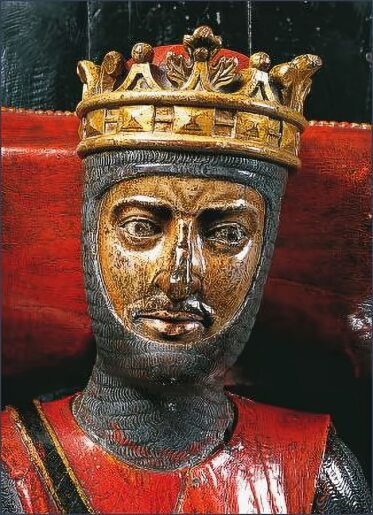
The last years of William's life were spent fighting in Normandy, Amongst those opposing him was his rebellious eldest son, Robert, nicknamed Curthose by his father, due to his short legs. In a battle in January 1079, Robert unhorsed William in combat and wounded him, ceasing his attack only when he recognized his father's voice. Humiliated, King William cursed his son then raised the siege and returned to Rouen.
At Easter 1080, reconciliation between father and son was engineered by Queen Matilda. The family were reunited in Breteuil, in northern France, for celebrations to mark the betrothal of William and Matilda's 14-year-old daughter, Adela, to Stephen, Count of Blois. Matilda then encouraged William to make peace with his estranged half-brother, Odo, the Bishop of Bayeux.
William
Tomb of William the Conqueror in the monastery of St.Stephen at Caen in Normandy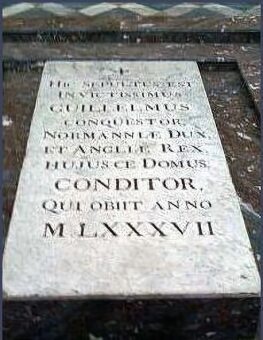
When Matilda fell seriously ill, William rushed to Normandy to be at her bedside. He wrote to Robert at Gerberol Castle, asking him to immediately come to Rouen. Matilda died at Caen, in November 1083 in her early fifties, after a lingering illness, her husband was at her bedside for her final confession. In her will she left large amounts of money to the poor and her royal sceptre and crown to Holy Trinity Abbey. She was buried in the choir of Holy Trinity, l'Abbaye aux Dames, her own foundation, in Caen, Normandy. Following her death William, much effected by her loss, was said to have became more short-tempered, gloomy and severe.
On 9th September 1087, whilst riding through the smouldering ruins of the sacked town of Mantes, in what must have appeared to him as, like an act of divine retribution, William was thrown from his horse when it trod on burning ashes and sustained severe abdominal injuries. The chronicler William of Malmesbury records:-his stomach protruding over the forward part of his saddle was injured when he was thrown against the pommel and his internal organs ruptured.) William retreated and returned to his capital at Rouen. His condition continued to worsen and, mindful of the afterlife to come, he "gave way to repeated sighs and groans." Begging those to pray for him, William confessed his sins and sought pardon. His treasure was distributed to the churches and the poor, "so that what I amassed through evil deeds may be assigned to the holy uses of good men.' Orderic Vitalis stated that William repented of the severity of his rule in England on his deathbed, 'I treated the native inhabitants of the kingdom with unreasonable severity, cruelly oppressed high and low, unjustly disinherited many, and caused the death of thousands by starvation and war, especially in Yorkshire... In mad fury, I descended on the English of the north like a raging lion and ordered that their homes and crops with all their equipment and furnishings should be burnt at once and their great flocks and herds of sheep and cattle slaughtered everywhere. So I chastised a great multitude of men and women with the lash of starvation and, alas! was the cruel murderer of many thousands, both young and old, of these fair people.'
The King, now aged fifty-nine and mortally injured, was carried to the convent of St. Gervais in Rouen, the Norman capital. There he summoned his younger sons, William and Henry, to his deathbed. Robert Curthose remained at the court of France. William confessed his sins and sought pardon. His treasure was distributed to the churches and the poor, "so that what I amassed through evil deeds may be assigned to the holy uses of good men."
England was bequeathed to his second surviving and favourite son, William Rufus and despite his bitter differences with Robert Curthose, he left Normandy to him. To Henry, the youngest son, later destined to inherit all his dominions, he left 5,000 silver pounds. He is reported to have ruminated on and repented of his many sins, transgressions and cruelties at the end. He tried to salve his conscience, before preparing to meet his maker and fearing for his immortal soul, he ordered all the treasure he possessed in Rouen to be given to the church and the poor and forgave his enemies. William the Conqueror died on 9th September 1087, having ruled England for 21 years.
William was buried in the monastery of St.Stephen at Caen in Normandy, an abbey he had previously founded as an act of repentance for his consanguineous marriage to Matilda of Flanders. The body was broken as it was lowered into the sepulchre, made too short by the stonemasons and the ceremony was interrupted by a dispossessed knight. A stone slab with a Latin inscription, in the abbey church of Caen today marks the burial place of the first Norman King of England. His grave has since been desecrated twice, in the course of the French Wars of Religion his bones were scattered across Caen, and during the tumultuous events of the French Revolution, the Conqueror's tomb was again despoiled.
The children and grandchildren of William the Conqueror and Matilda of Flanders
(1) Robert 'Curthose' Duke of Normandy (1054 -1134) m.Sybilla of Conversano
(i) William Clito, Count of Flanders (d.1128) m. Sybil of Anjou
(2) Richard (circa 1055 - 1081)
(3) WILLIAM II (circa 1056 - 1100)
(4) Cecilia (d.1126)
(5) Adeliza
(6) Adela (circa 1062 - 1138) m. Stephen, Count of Blois
(i) Matilda (d. 1120)
(ii) Theobald, Count of Blois (d. 1151)
(iii) Henry, Bishop of Winchester
(iv)STEPHEN, KING OF ENGLAND (d. 1154) m. Matilda of Boulogne
(v) William
(7) HENRY I (circa 1068 - 1135) m. (i)Edith of Scotland (ii) Adeliza of Louvain Issue by (i):-
(i)William the Atheling (circa 1103-1128)m. Matilda of Anjou
(ii) MATILDA (circa 1103 - 1162) m. (i) Henry V, Holy Roman Emperor (ii) Geoffrey Plantagenet, Count of Anjou
Norman Index PreviousNext William IIRufus
